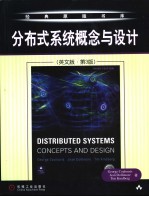

分布式系统概念与设计PDF电子书下载
- 电子书积分:21 积分如何计算积分?
- 作 者:库勒瑞思(Coulouris,G.)等著
- 出 版 社:北京:机械工业出版社
- 出版年份:2003
- ISBN:7111117492
- 页数:772 页
1 CHARACTERIZATION OF DISTRIBUTED SYSTEMS 1
1.1 Introduction 2
1.2 Examples of distributed systems 3
1.3 Resource sharing and the Web 7
1.4 Challenges 16
1.5 Summary 25
2 SYSTEM MODELS 29
2.1 Introduction 30
2.2 Architectural models 31
2.3 Fundamental models 47
2.4 Summary 62
3 NETWORKING AND INTERNETWORKING 65
3.1 Introduction 66
3.2 Types of network 70
3.3 Network principles 73
3.4 Internet protocols 90
3.5 Network case studies: Ethernet, wireless LAN and ATM 110
3.6 Summary 121
4 INTERPROCESS COMMUNICATION 125
4.1 Introduction 126
4.2 The API for the Internet protocols 127
4.3 External data representation and marshalling 138
4.4 Client-server communication 145
4.5 Group communication 153
4.6 Case study: interprocess communication in UNIX 158
4.7 Summary 161
5 DISTRIBUTED OBJECTS AND REMOTE INVOCATION 165
5.1 Introduction 166
5.2 Communication between distributed objects 169
5.3 Remote procedure call 183
5.4 Events and notifications 187
5.5 Java RMI case study 194
5.6 Summary 202
6 OPERATING SYSTEM SUPPORT 207
6.1 Introduction 208
6.2 The operating system layer 209
6.3 Protection 212
6.4 Processes and threads 214
6.5 Communication and invocation 231
6.6 Operating system architecture 242
6.7 Summary 246
7 SECURITY 251
7.1 Introduction 252
7.2 Overview of security techniques 261
7.3 Cryptographic algorithms 272
7.4 Digital signatures 282
7.5 Cryptography pragmatics 289
7.6 Case studies: Needham-Schroeder, Kerberos, SSL Millicent 291
7.7 Summary 307
8 DISTRIBUTED FILE SYSTEMS 309
8.1 Introduction 310
8.2 File service architecture 318
8.3 Sun Network File System 323
8.4 The Andrew File System 335
8.5 Recent advances 344
8.6 Summary 350
9 NAME SERVICES 353
9.1 Introduction 354
9.2 Name services and the Domain Name System 357
9.3 Directory and discovery services 371
9.4 Case study of the Global Name Service 374
9.5 Case study of the X.500 Directory Service 378
9.6 Summary 382
10 TIME AND GLOBAL STATES 385
10.1 Introduction 386
10.2 Clocks, events and process states 387
10.3 Synchronizing physical clocks 389
10.4 Logical time and logical clocks 397
10.5 Global states 400
10.6 Distributed debugging 409
10.7 Summary 416
11 COORDINATION AND AGREEMENT 419
11.1 Introduction 420
11.2 Distributed mutual exclusion 423
11.3 Elections 431
11.4 Multicast communication 436
11.5 Consensus and related problems 451
11.6 Summary 462
12 TRANSACTIONS AND CONCURRENCY CONTROL 465
12.1 Introduction 466
12.2 Transactions 469
12.3 Nested transactions 480
12.4 Locks 482
12.5 Optimistic concurrency control 497
12.6 Timestamp ordering 501
12.7 Comparison of methods for concurrency control 508
12.8 Summary 509
13 DISTRIBUTED TRANSACTIONS 515
13.1 Introduction 516
13.2 Flat and nested distributed transactions 516
13.3 Atomic commit protocols 519
13.4 Concurrency control in distributed transactions 528
13.5 Distributed deadlocks 531
13.6 Transaction recovery 539
13.7 Summary 549
14 REPLICATION 553
14.1 Introduction 554
14.2 System model and group communication 556
14.3 Fault-tolerant services 565
14.4 Highly available services 572
14.5 Transactions with replicated data 591
14.6 Summary 603
15 DISTRIBUTED MULTIMEDIA SYSTEMS 607
15.1 Introduction 608
15.2 Characteristics of multimedia data 612
15.3 Quality of service management 614
15.4 Resource management 623
15.5 Stream adaptation 625
15.6 Case study: the Tiger video file server 627
15.7 Summary 632
16 DISTRIBUTED SHARED MEMORY 635
16.1 Introduction 636
16.2 Design and implementation issues 640
16.3 Sequential consistency and Ivy 649
16.4 Release consistency and Munin 657
16.5 Other consistency models 663
16.6 Summary 664
17 CORBA CASE STUDY 669
17.1 Introduction 670
17.2 CORBA RMI 671
17.3 CORBA services 688
17.4 Summary 695
18 MACH CASE STUDY 699
18.1 Introduction 700
18.2 Ports, naming and protection 703
18.3 Tasks and threads 705
18.4 Communication model 707
18.5 Communication implementation 710
18.6 Memory management 713
18.7 Summary 719
REFERENCES 723
INDEX 757
- 《管理信息系统习题集》郭晓军 2016
- 《指向核心素养 北京十一学校名师教学设计 英语 七年级 上 配人教版》周志英总主编 2019
- 《信息系统安全技术管理策略 信息安全经济学视角》赵柳榕著 2020
- 《设计十六日 国内外美术院校报考攻略》沈海泯著 2018
- 《计算机辅助平面设计》吴轶博主编 2019
- 《高校转型发展系列教材 素描基础与设计》施猛责任编辑;(中国)魏伏一,徐红 2019
- 《景观艺术设计》林春水,马俊 2019
- 《大数据Hadoop 3.X分布式处理实战》吴章勇,杨强 2020
- 《高等教育双机械基础课程系列教材 高等学校教材 机械设计课程设计手册 第5版》吴宗泽,罗圣国,高志,李威 2018
- 《系统解剖学速记》阿虎医考研究组编 2019
- 《指向核心素养 北京十一学校名师教学设计 英语 七年级 上 配人教版》周志英总主编 2019
- 《北京生态环境保护》《北京环境保护丛书》编委会编著 2018
- 《高等教育双机械基础课程系列教材 高等学校教材 机械设计课程设计手册 第5版》吴宗泽,罗圣国,高志,李威 2018
- 《指向核心素养 北京十一学校名师教学设计 英语 九年级 上 配人教版》周志英总主编 2019
- 《高等院校旅游专业系列教材 旅游企业岗位培训系列教材 新编北京导游英语》杨昆,鄢莉,谭明华 2019
- 《中国十大出版家》王震,贺越明著 1991
- 《近代民营出版机构的英语函授教育 以“商务、中华、开明”函授学校为个案 1915年-1946年版》丁伟 2017
- 《新工业时代 世界级工业家张毓强和他的“新石头记”》秦朔 2019
- 《智能制造高技能人才培养规划丛书 ABB工业机器人虚拟仿真教程》(中国)工控帮教研组 2019
- 《AutoCAD机械设计实例精解 2019中文版》北京兆迪科技有限公司编著 2019
